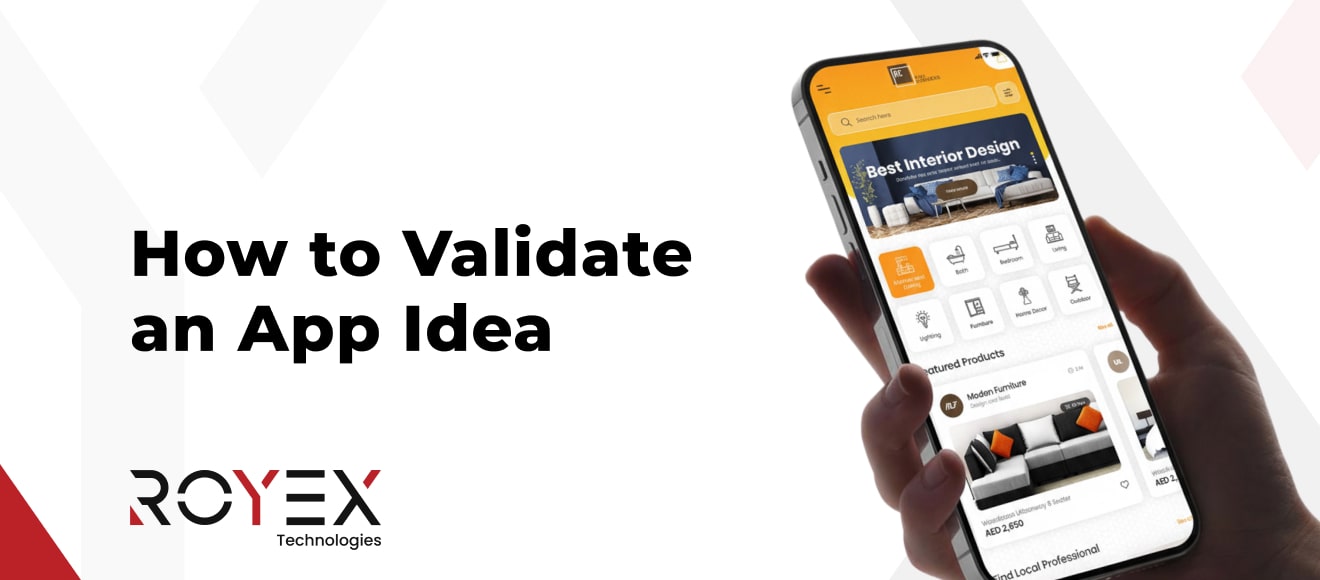
How to Validate an App Idea
Turning your app idea into a successful product starts long before writing code. Many good ideas fail because they never sufficiently validate that the idea is real, needed, and can succeed. This article will walk you through how to validate an app idea fully: different methods, when to use which, pros & cons, key metrics, statistics, and decision signals. Also, why choosing a competent development partner like Royex can make a big difference.
Based on common questions asked by our customers before developing mobile apps, we have listed most of the questions and answers in detail for each of the questions. This is a series of Articles about “Mobile App Journey: Things You Must Know”
Why App-Idea Validation Is Essential
Before getting into the “how,” here are some reasons why validation is not optional but essential:
- High failure rate: Many sources estimate that 80-90% of new apps fail or don’t achieve sustainable success. (Zignuts)
- Cost savings: Building a fully featured app without validation can waste large sums of money and time. Validation helps catch wrong assumptions early. (Zignuts)
- Better product-market fit: Validated ideas are more likely to match real user needs, which improves user adoption, retention, word-of-mouth, etc.
- Investor confidence: If you need funding, validated ideas (with data, prototypes, user feedback) are taken more seriously.
With that in mind, the rest of this article will cover how to do that validation in detail.
Key Steps & Methods for Validating an App Idea
There are many methods; often you combine a few. Here are the main ones, what kinds of apps they suit, how to do them, pros & cons.
Process / Stages of Validation & When to Use Each
Below is a suggested timeline or sequence, roughly, of how to apply these methods, from early light-touch to more heavy investment.
When Which Method is Best: Types of Apps & Matching Validation Methods
Different kinds of apps or domains benefit more from certain methods; some methods are less useful for certain apps. Here’s guidance.
Key Metrics & What Counts as “Good” Validation
When you run tests / MVPs, some metrics are especially useful. Here are what to watch, and thresholds / benchmarks (where available):
Some Relevant Statistics
Here are statistics from recent years to help frame what’s common, what’s realistic, and what to expect:
- In an article by Zignuts (2025), they said “80-90% of apps fail within the first year,” largely because they didn’t validate that there was a demand. (Zignuts)
- According to Zignuts, validating ideas properly can save 60-80% of initial development cost by avoiding building unwanted features. (Zignuts)
- From UpStack Studio’s App Idea Validation in 2024 guide: step by step, many founders are using tools like Google Trends, Data.ai, Statista, competitor reviews, user personas, etc., and relying heavily on MVPs + feedback loops. (Upstack Studio)
- From multiple sources: willingness to pay is often overestimated by creators; actual conversion from free users to paid / subscribers tends to be low (often < 5-10%, depending on app type). (Though specific numbers vary by domain and geography.) — this emerges from review of competitor analyses and user feedback data. (Upstack Studio)
Pros & Cons Summary of All Methods
To help you decide which mix of validation methods to use, here’s a summarized view of trade-offs.
- Low cost methods (trend research, competitor analysis, surveys) have low financial risk, but may give only partial insight; often good to start with, but not sufficient on their own.
- Prototype / MVP / Beta gives real user behavior data; but cost and time are higher; risk of negative feedback / first impression issues.
- Pre-selling or paid tests gives strong signal for willingness to pay, but high risk if you underdeliver or misjudge expectations; also might limit audience.
- Wizard-of-Oz / Concierge approaches allow testing with minimal tech; but may misrepresent actual scaling challenges or user expectations when automation is added.
- Metrics / user behaviour tracking essential, but require sufficient user volume; early data may be noisy or misleading.
- Fake door / landing page tests are fast and cheap; but may over-represent interest (people click, but later drop off)
How to Decide: Go / Pivot / Abandon
Even with validation, many ideas still need adjustment. Here are signals (both positive and negative) to guide your decision whether to proceed, pivot, or drop the idea.
Negative Signals (Pivot / Abandon)
- Very low interest or sign-ups despite good messaging
- Users express confusion about what problem the app solves, or say they already have adequate alternatives
- High drop-off / very low retention in prototype / beta version
- Users say unwilling to pay or that price is too high; or monetization tests fail
- You find that addressing the core problem is more complex / expensive than expected (technical, regulatory, user trust etc.)
- Feedback consistently points to needing a different direction / feature set
Positive Signals (Go or Continue Investing)
- Good sign-ups or pre-orders; people are willing to commit early
- Users find the prototype useful, engage with core features repeatedly
- Retention, engagement metrics are acceptable or improving
- Monetization tests (pricing, subscription, in-app purchases) show promise; some users willing to pay
- Feedback reveals clear guidance for improvements; you have a path forward for scaling and maintaining
Examples of Validation in Practice
Here are some hypotheticals or real-inspired examples to illustrate:
- A health & wellness app: the founders survey people with certain health issues to understand their biggest pain points; build a prototype of a tracking + tips feature; release to a small group; track retention; test if users would pay for premium coaching or extra content.
- A niche photo editing tool: competitor apps exist, but many user reviews complain about “limited free filters”, “poor export options”, “clunky UI”. The founder builds a mockup, uses a landing page to get email sign-ups for “new filters + better UI”; offers early access; then builds MVP with core editing + export; tests pricing for filter packs.
- An enterprise B2B logistics app: founders interview prospective client companies (fleet managers, drivers), do competitor research, build a simple prototype or proof-of-concept; partner with one company for pilot; measure the time savings, cost savings; get feedback; adjust tech & UX; test licensing / subscription pricing.
Best Practices & Tips
Here are actionable best practices to make your validation more effective:
- Start with Assumptions & Hypotheses: List out what you assume (user need, features, pricing, audience). Each assumption becomes something you validate.
- Validate the Problem First Before Solution: Many people build “features” rather than solving real pain. Make sure the problem is real, painful, and widespread.
- Recruit Real Target Users: Feedback from friends/family often misleading; get people who represent your target audience.
- Keep It Lean & Fast: Avoid over-engineering early prototypes; build what you need to test your assumptions, no more.
- Be Data-Driven but Qualitative Too: Combine metrics (retention, sign-ups) with qualitative user feedback (why users left, what they expect).
- Iterate Quickly: Use early feedback to refine; adjust features, UX, pricing.
- Be Willing to Pivot or Abandon: It’s better to change direction early than invest in something flawed.
- Watch Regulatory, Privacy, Trust Factors: Especially for health, finance, children’s apps; early awareness of compliance, privacy, user trust is important.
- Test for Monetization Early Enough: Even if your initial goal isn’t revenue, knowing whether people will pay or tolerate monetization strategy matters early.
- Document All Findings: Keep a record of what you tested, what worked / didn’t; helps avoid repeating mistakes; helps if involving partners or investors.
Common Questions in Validation & Answers
(These are ones we often get from clients / those starting out.)
Decision: When to Build / Launch
After you've done the validation work, here’s how to decide:
- If you see consistent evidence: users want your app, users use core feature, retention acceptable, some willing to pay, or at least accept monetization path → move forward and build properly.
- If some parts validated and others not: you may pivot—perhaps change feature scope, target audience, business model.
- If little or no validation signals: consider abandoning or shelving the idea, or using it more as a learning experiment rather than large investment.
Statistics & Benchmarks You Should Know
- Many app creators find that less than 5% of survey respondents convert into paying users when using typical freemium/subscription models; this fraction can vary by region, app type, pricing, and value delivered. (This is a common result in competitor analyses and case studies.)
- Retention benchmarks (consumer apps): Day-1 retention often around 30–40%, Day-7 around 10–20%; these drop quickly without strong onboarding or value delivery.
- Conversion rates in landing pages / fake door tests: when messaging is strong, good value prop, conversion can be a few percent.
- Cost saving via early validation: reports suggest you can save 60-80% of initial development cost by catching wrong assumptions early. (Zignuts)
Why Royex Is an Excellent Partner for Validating & Building Apps
When you are validating an app idea, having a trustworthy, skilled partner can significantly improve your chances. Here’s why Royex Technologies is often considered one of the best in mobile app development and validation:
- Experience Across Domains & Markets
Royex has worked on many projects across consumer, enterprise, social, health, e-commerce etc. That means they’ve seen what works, what pitfalls are common, and can bring that insight to your validation process. - Structured Validation Process
Royex doesn’t just build; they often begin with discovery workshops: defining problem statements, target personas, competitive landscape, use of tools like market trend research, sketch / prototype / MVP etc. This helps ensure you are validating the right assumptions. - Strong UX / UI & Prototyping Skills
One common cause of failure is poor user experience. Royex’s design teams ensure that prototypes / MVPs are good enough to test real user reactions: intuitive design, proper flows, feedback gathering, usability. This reduces risk in validation. - Technical Competence & Scalability
Even when building an MVP, the foundation must be solid if you intend to scale. Royex has a track record of building technical architectures that scale, integrating data / analytics, privacy, security—so that when you validated you’re not hampered by technical debt. - Focus On Metrics & Analytics
Royex builds in data tracking, retention, engagement measurement, feedback loops into early versions. So you don’t just get “looks nice”, you get measurable signals. - Flexible & Lean Approach
They are used to working with lean, budget-sensitive validation phases: using prototypes, MVPs, fake doors, etc., so that you don’t overspend before knowing your idea is viable. - Post-Launch Support & Iteration
Validating and launching is not the end. Royex offers maintenance, iteration, updates, and helps pivot features or UX based on real user data post-launch, which many companies neglect.
Summary & Recommended Roadmap
Putting all the above together, here’s a compact recommended roadmap for validating your app idea:
- Define idea, problem, audience, business hypotheses & assumptions.
- Do market & trend research + competitor analysis.
- Conduct user interviews / surveys to test problem validity.
- Create a prototype / sketch or mockup & test with real users (usability, clarity).
- Build a small MVP or launch a landing page / fake door to test interest / willingness to pay.
- Pilot / beta test with real users, track metrics like retention, engagement, user feedback.
- Test monetization / pricing models if applicable.
- Review all data: if key metrics are good, proceed; otherwise adjust / pivot / decide.
Conclusion
Validating an app idea is not glamorous or sexy, but it’s far more cost-effective and important than building full apps with uncertain demand. It reduces risk, sharpens focus, ensures you are solving a real problem, and helps in making informed decisions. Using a mix of the above methods—starting lightly, then increasing investment as signals get stronger—is generally the best way.
If you do that, and partner with a mobile app development company in Dubai like Royex that brings experience, lean processes, strong design & technical ability, and metric-driven iteration, you significantly increase the chances your app idea becomes a successful, sustainable product.
Sources
Here are the sources used in this article:
- UpStack Studio — “App Idea Validation in 2024: A Step-By-Step Guide” (Upstack Studio)
- Zignuts — “How to Validate Your App Idea Without Spending Thousands” (2025) (Zignuts)
- Wikipedia — “Minimum viable product” definition etc. (Wikipedia)





